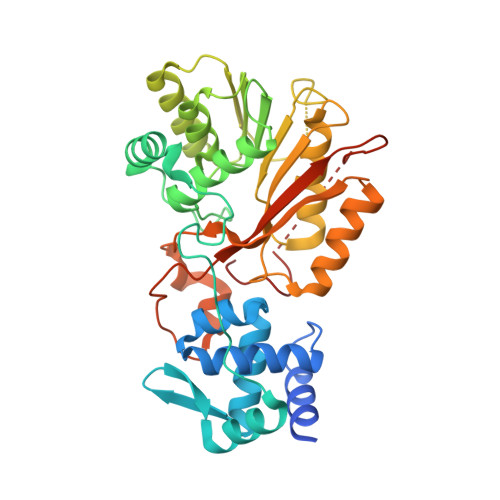Active site geometry of a novel aminopropyltransferase for biosynthesis of hyperthermophile-specific branched-chain polyamine.
Hidese, R., Tse, K.M., Kimura, S., Mizohata, E., Fujita, J., Horai, Y., Umezawa, N., Higuchi, T., Niitsu, M., Oshima, T., Imanaka, T., Inoue, T., Fujiwara, S.(2017) FEBS J 284: 3684-3701
- PubMed: 28881427
- DOI: https://doi.org/10.1111/febs.14262
- Primary Citation of Related Structures:
5XNC, 5XNF, 5XNH - PubMed Abstract:
Branched-chain polyamines are found exclusively in thermophilic bacteria and Euryarchaeota and play essential roles in survival at high temperatures. In the present study, kinetic analyses of a branched-chain polyamine synthase from the hyperthermophilic archaeon Thermococcus kodakarensis (Tk-BpsA) were conducted, showing that N 4 -bis(aminopropyl)spermidine was produced by sequential additions of decarboxylated S-adenosylmethionine (dcSAM) aminopropyl groups to spermidine, through bifunctional catalytic action. Tk-BpsA catalyzed the aminopropylation of the linear-chain polyamines spermidine, spermine, norspermidine, and the tertiary-branched polyamines N 4 -aminopropylspermidine and N 4 -aminopropylnorspermidine, but not of short-chain diamines, putrescine, and cadaverine, suggesting that Tk-BpsA does not catalyze the aminopropylation of primary amino groups of diamines. X-ray structural analyses of Tk-BpsA in the presence or absence of the substrates spermidine and dcSAM revealed that a large, negatively charged cavity is responsible for the binding of branched-chain substrates. The binding is different from that in the active site of linear polyamine spermidine/spermine synthases, and loop-closures occur upon the binding of spermidine. Based on structural analyses, further kinetic studies were carried out for various mutants, revealing that Asp159, positioned between the reactive secondary amino group of the substrate polyamine and a sulfur atom of the product 5'-methylthioadenosine and in a Gly-Asp-Asp-Asp motif, functions as a catalytic center, with reactions proceeding via a ping-pong mechanism. Our study provides a novel aminopropyltransfer reaction mechanism, distinct from the S N 2 displacement mechanism found in other known linear spermidine/spermine synthases. Atomic coordinates and structure factors have been deposited in the Protein Data Bank with PDB codes 5XNF for apo-Tk-BpsA, 5XNH for the binary complex, and 5XNC for the ternary complex.
Organizational Affiliation:
Department of Bioscience, Graduate School of Science and Technology, Kwansei-Gakuin University, Sanda, Japan.
















